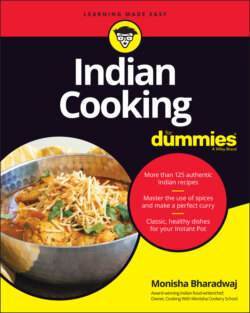Читать книгу Indian Cooking For Dummies - Monisha Bharadwaj - Страница 85
Aromatics and herbs: Veggies with a punch
ОглавлениеFresh aromatics and herbs are as important as spices. Here’s what to look for when choosing them and how best to store them:
Fresh chilies: You’ll want to use the same variety of chile every time, so you know how hot it is whenever you use it and not have to play chile roulette. I prefer the bird’s eye or thin green chilies. The smaller the chile, the hotter it is, so these are pretty powerful. You can control the heat by the way you chop them (see Chapter 6). Most recipes ask for fresh green chilies, although you can use red ones as well. Red chilies are just green chilies that have ripened, so they have a shorter shelf life. You can freeze fresh chilies, but use them from frozen because they go limp when defrosted.
Cilantro and mint: An Indian store will have big, fresh bunches tied together as opposed to a few stalks you see wrapped in plastic bags in bigger supermarkets. To store, line a large, airtight plastic box with paper towel and place the herbs in. Store in the fridge for a couple of weeks, replacing the paper towel every few days.
Curry leaves: You’ll find the freshest ones in the Indian market. The stalks are sold in small plastic bags. It’s easy to dry them at home, and they taste much better than the dried ones you can buy commercially. Just take them off the stalks and dry them on a tray on your kitchen counter for three to four days. Put the dehydrated leaves into an airtight box in the fridge up to two months. If you can’t find fresh curry leaves, the store-bought dried ones will do.
Fenugreek: Fenugreek leaves are available as a fresh bunch and are used in vegetable dishes the way spinach is used. They’re also dried to use as a herb called kasuri methi, which is available in packs and will last up to a year if stored in a cool, dark place. Fenugreek is the essential flavor in dishes such as Murgh Makhani (Butter Chicken; see Chapter 11). Fenugreek seeds are the spice and can’t be used in place of kasuri methi.
Garlic: Much of what you see in the produce aisles is Chinese garlic. You can tell by the fact that it’s sold rootless, which reduces shipping weight and costs. Garlic grown domestically mostly has roots. You can use either type. Choose fat bulbs that don’t collapse when you press them and look for mold around the root end, which is a sign that they’re going bad. Store garlic in your onion basket or in the fridge.
Ginger: Most of the ginger you see in your grocery store probably comes from China, but you may also find organic ginger from Peru. Look for firm, shiny-skinned ginger with as little discoloration as possible. A crinkly skin means that it’s getting a bit old and dehydrated, so the flesh will most likely be very stringy.The best thing you can do with ginger and garlic is make your own paste, a lovely homemade ingredient that will speed up your Indian cooking. (You can find out how to make and store your own ginger-garlic paste in Chapter 6.)If you want to leave some ginger whole, store it wrapped in paper in the fridge or freezer and grate from frozen into curries.
